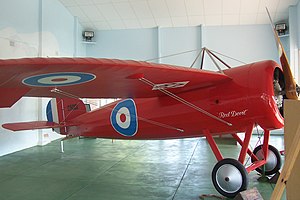Bristol M.1C
| Bristol M.1C | |
|---|---|

| |
| Role | Fighter/Reconnaissance |
| Manufacturer | Bristol |
| Designer | Frank Barnwell [1][2][3] |
| First flight | Sep 1916 [1] |
| Introduction | June 1917[1] to Sept 1917[4] |
| Primary user | |
| Number built | 125 [1][3] |
| Wingspan | 9.37 m (30 ft 9 in) [5][6][3] |
| Propeller Diam. | 2.60 m (8 ft 6.5 in)[3] |
| Engine | 110hp Le Rhône rotary |
| Armament | fixed sync. Vickers |
| Max Speed | 210 km/h (130 mph)[7][8][5][6][4] |
| Climb | 1,800 m (6,000 ft) in 5:10[7][5] 2,000 m (6,500 ft) in 5:30[3] 3,000 m (10,000 ft) in 10:10[3]-10:25[7][5] 4,600 m (15,000 ft) in 19:50[3] |
| Ceiling | 6,100 m (20,000 ft) [7][8][5][6][3] |
| Endurance | 1:45 [7][8][6][3] |
It was a radical departure in 1916 to return to the monoplane formula, so much so that the Bristol M.1 was never given a fair chance on the Western front despite its speed, climb, and maneuverability.
The M.1A was the prototype, and four further examples were built as the M.1B for service trials with various engines. Thirty-five production M.1Cs were sent to the Middle East in 1917, but they never fully equipped any squadron.
The pre-war ban on monoplanes carried over into the rest of the war, and the M.1 was never given much of a chance despite glowing statistics. Perhaps its only true faults was restricted downward vision (hardly unique to monoplanes), and that was somewhat rectified by the addition of clear panels near the wing roots in the M.1C. Seventeen M.1s were sent to the Middle East in 1917, followed by eighteen more in 1918. Two were sent to training units in 1917 followed by 39 in 1918, six were sent to Chile, others to Macedonia.[9]
We can only wonder how the war might have been different had the M.1 been produced and used in numbers starting in mid-1917.
For more information, see Wikipedia:Bristol M.1.
Timeline [note 1]

Game Data
Wings of Glory
| Maneuver | Damage | Dmg Points | Max Alt. | Climb |
|---|---|---|---|---|
| N | B | 14 | 13 | 3 |
Card Links
Blue Max/Canvas Eagles
Miniatures and Models
1:144 Scale
- Shapeways: Decapod, Kampfflieger
References
- Notes
- Citations
- ↑ 1.0 1.1 1.2 1.3 Bruce'69, p.144.
- ↑ Angelucci, p.56.
- ↑ 3.0 3.1 3.2 3.3 3.4 3.5 3.6 3.7 3.8 Bruce'67, p.12.
- ↑ 4.0 4.1 Bruce'67, p.7.
- ↑ 5.0 5.1 5.2 5.3 5.4 Lamberton, pp.212-213.
- ↑ 6.0 6.1 6.2 6.3 Angelucci, p.45.
- ↑ 7.0 7.1 7.2 7.3 7.4 Bruce'69, p.147.
- ↑ 8.0 8.1 8.2 Munson, p.83.
- ↑ Bruce'67, p.10.
- ↑ Philpott'13, pp.379-444.
- Bibliography
- Enzo Angelucci, ed. The Rand McNally Encyclopedia of Military Aircraft, 1914-1980. New York: The Military Press, 1983 edition. ISBN 0-517-41021-4.
- J.M. Bruce. British Aeroplanes 1914-18. Great Britain: Funk & Wagnalls, 1957, 1969. ISBN 0370000382
- J.M. Bruce, Profile Publications 193: The Bristol M.1. Great Britain: Profile Publications, Ltd., 1967.
- W.M. Lamberton and E.F. Cheesman, Fighter Aircraft of the 1914-1918 War. Great Britain: Harleyford Publications Limited, 1960.
- Kenneth Munson, Fighters 1914-19, Attack and Training Aircraft. New York: MacMillan Publishing Co., Inc., 1976. ISBN 0713707607
- Ian Philpott, The Birth of the Royal Air Force. Great Britain: Pen & Sword Books Limited, 2013. ISBN 978-1-78159-333-2